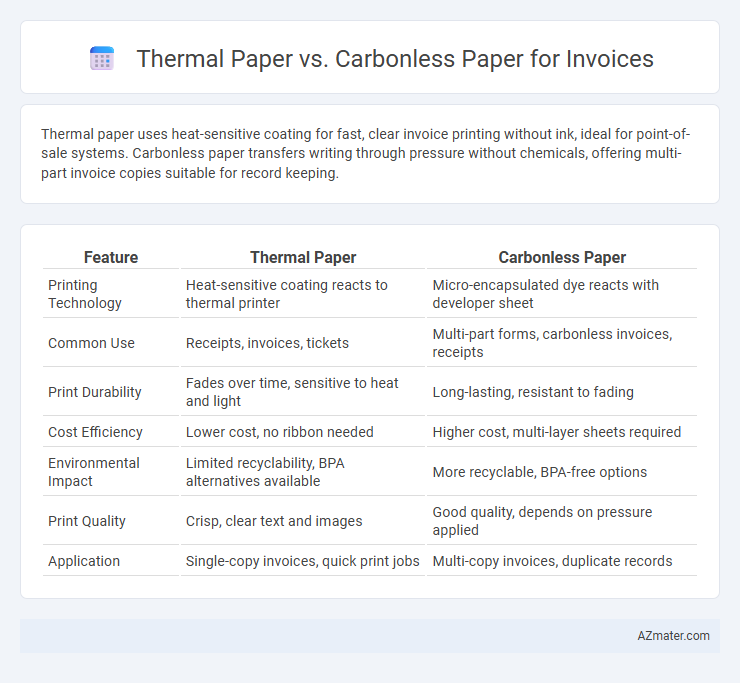Thermal paper uses heat-sensitive coating for fast, clear invoice printing without ink, ideal for point-of-sale systems. Carbonless paper transfers writing through pressure without chemicals, offering multi-part invoice copies suitable for record keeping.
Table of Comparison
| Feature | Thermal Paper | Carbonless Paper |
|---|---|---|
| Printing Technology | Heat-sensitive coating reacts to thermal printer | Micro-encapsulated dye reacts with developer sheet |
| Common Use | Receipts, invoices, tickets | Multi-part forms, carbonless invoices, receipts |
| Print Durability | Fades over time, sensitive to heat and light | Long-lasting, resistant to fading |
| Cost Efficiency | Lower cost, no ribbon needed | Higher cost, multi-layer sheets required |
| Environmental Impact | Limited recyclability, BPA alternatives available | More recyclable, BPA-free options |
| Print Quality | Crisp, clear text and images | Good quality, depends on pressure applied |
| Application | Single-copy invoices, quick print jobs | Multi-copy invoices, duplicate records |
Introduction to Invoice Paper Types
Invoice paper types primarily include thermal paper and carbonless paper, each designed for distinct printing technologies. Thermal paper features a heat-sensitive coating that produces images when exposed to a thermal printer's heat, offering fast, quiet printing without ink. Carbonless paper utilizes micro-encapsulated dye or ink that reacts upon pressure, enabling multi-part forms without carbon sheets, making it ideal for duplicate or triplicate invoices.
What is Thermal Paper?
Thermal paper is a specially coated paper designed to change color when exposed to heat, making it ideal for fast and efficient printing without the need for ink or ribbons. This type of paper is commonly used in point-of-sale systems, receipts, and invoices due to its high-speed printing capability and clear, durable print quality. Thermal paper offers advantages such as reduced maintenance costs and cleaner printing processes compared to carbonless paper, which relies on chemical layers for image transfer.
What is Carbonless Paper?
Carbonless paper, also known as NCR (No Carbon Required) paper, is a multi-layered paper designed to transfer information written on the top sheet to the sheets beneath without the need for carbon paper. It contains micro-encapsulated dye or ink on the back of the top sheet and a reactive clay coating on the front of the sheet below, which react under pressure to create a duplicate copy. This type of paper is commonly used for invoices, receipts, and forms where multiple copies are required instantly without using a separate carbon sheet.
Print Technology Differences
Thermal paper uses heat-sensitive coatings that create images when exposed to a thermal printhead, offering fast and quiet printing without ink or toner. Carbonless paper relies on micro-encapsulated dye or ink that transfers through pressure from writing or impact printing to subsequent sheets, enabling multi-part invoice copies without carbon sheets. The choice hinges on the need for direct thermal printing with single-sheet use versus multi-layered pressure-based duplication.
Durability and Longevity
Thermal paper, coated with heat-sensitive chemicals, offers quick print speeds but is prone to fading and darkening over time, especially when exposed to heat, light, or humidity, limiting its durability and longevity for invoice storage. Carbonless paper uses micro-encapsulated dye or ink that transfers through impact, providing more stable and long-lasting copies resistant to environmental factors, making it ideal for archival-quality invoices. For businesses requiring durable records, carbonless paper ensures better preservation and readability compared to thermal paper's more temporary nature.
Cost Comparison
Thermal paper invoices generally cost less upfront due to simpler printing technology and no need for ink or toner. Carbonless paper invoices incur higher initial expenses from multi-layer sheets and specialized coatings but eliminate the need for separate printing consumables. Over time, thermal paper offers lower overall costs for high-volume printing, while carbonless paper suits low-volume, multi-part invoice needs despite higher per-unit prices.
Environmental Impact
Thermal paper used for invoices contains BPA or BPS chemicals, raising concerns about environmental toxicity and recycling challenges, whereas carbonless paper, though free of these chemicals, involves chemical coatings that can affect biodegradability. Carbonless paper typically generates less waste and can be recycled more easily than thermal paper, reducing landfill impact and pollution. Choosing carbonless paper supports eco-friendly invoicing practices by minimizing harmful chemical exposure and enhancing sustainability in office environments.
Security Features
Thermal paper for invoices incorporates chemical coatings that react to heat, making tampering or alterations evident through visible discoloration or damage, which enhances fraud detection. Carbonless paper uses micro-encapsulated dye or ink that transfers images without carbon sheets, with security features including pressure sensitivity and resistance to erasure. Carbonless invoices often lack the heat-sensitive security benefits of thermal paper but provide reliable multi-part copies essential for verification and record-keeping.
Common Uses in Invoicing
Thermal paper is widely used for printing receipts and invoices in retail and hospitality due to its fast, quiet printing and low maintenance with thermal printers. Carbonless paper, often employed for multi-copy invoices and forms, allows instant duplicate or triplicate copies without the need for carbon sheets, making it ideal for delivery receipts and contracts requiring multiple copies. Both types optimize invoicing efficiency but differ in application based on the need for original and duplicate records.
Choosing the Right Paper for Your Business
Choosing between thermal paper and carbonless paper for invoices hinges on your business's printing needs and cost efficiency. Thermal paper offers fast, smudge-free printing ideal for point-of-sale receipts, while carbonless paper excels in creating duplicate or triplicate copies without the need for carbon sheets, which is valuable for record-keeping and client transparency. Evaluate factors like printer compatibility, durability, and the frequency of invoice duplication to select the optimal paper type that supports your business operations and enhances workflow efficiency.

Infographic: Thermal paper vs Carbonless paper for Invoice
 azmater.com
azmater.com